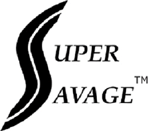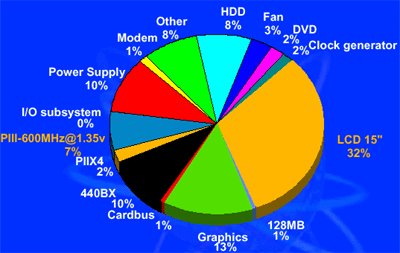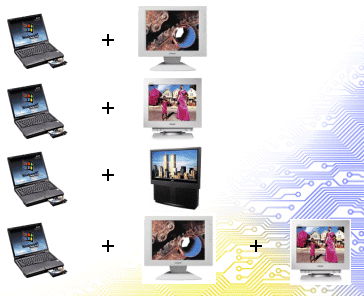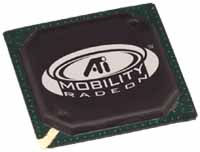
Original Link: https://www.anandtech.com/show/736
S3 SuperSavage MX/IX Mobile 3D Accelerator
by Anand Lal Shimpi on March 14, 2001 3:50 AM EST- Posted in
- GPUs
Introduction
It was S3 that first brought true 3D acceleration to the notebook market with their Savage MX and IX parts close to two years. The Savage MX/IX series of 3D accelerators brought 30 fps 3D gaming to mobile users, which was more than the competition could offer at the time. It was a leaps and bounds above the solutions from NeoMagic and CirrusLogic that helped dominate the mobile graphics market, offering no more than 128-bit 2D acceleration and VGA output but it was still years behind what was possible on desktop platforms.
At the same time, developments in the desktop graphics market were making the notebook OEMs salivate at the thought of putting some of that power in their laptops. The introduction of NVIDIA's GeForce2 MX was met with quite a bit of interest, as this desktop part was just a hair away from being low power enough to be used in a laptop. If you remember the GeForce2 MX running at 175MHz was only consuming 4W of power and with the Savage MX/IX solutions consuming ~2W, NVIDIA wasn't too far off from having a killer mobile part on their hands.
While it took a little longer than expected, at the Fall Comdex 2000, NVIDIA introduced the GeForce2 Go, which was a lower clocked GeForce2 MX (143MHz vs. 175MHz) adapted to a mobile platform. The decreased clock speed combined with some light power saving features gave the GeForce2 Go the ability to live off of 2.8W of power. So the chip that ran at ~82% of its desktop counterpart's clock speed ran with 70% of its power, impressive, but still not impressive enough. Quite possibly the most impressive part of the GeForce2 Go's launch was that it is currently available in Toshiba laptops whereas it took S3 and ATI entirely too long to get their previous generation mobile 3D accelerators into shipping laptops.
ATI then struck back with the Radeon Mobility that has yet to be seen in shipping laptops but promises performance comparable to GeForce2 Go with apparently lower power consumption levels. The fact of the matter is that until ATI can show the Radeon Mobility in a shipping laptop, NVIDIA can enjoy their claim to fame; all 2.8W of it.
This brings us in a full circle back to what we started this introduction with, the Savage MX and IX chips. Outside of their joint venture with VIA, the Savage2000 blunder was pretty much the last we had heard from S3. Since then S3 has been de-emphasizing their role in the performance graphics market and has instead been focusing on their strengths: their SONICblue line of audio devices, their integrated video solutions and of course, their mobile products.
With NVIDIA and ATI threatening their market share in the mobile market, S3 is finally ready to respond with their SuperSavage line of mobile graphics accelerators; and surprisingly enough, they're not targeting the GeForce2 Go as their competition.
The Savage4 is good for something
 We
found relatively little use for the Savage4 as a "high-performance"
add-in graphics card during its time, however since then the chip has been put
to a number of more useful tasks. For one, the Savage4 core was used in VIA's
line of value chipsets with integrated video. More recently, the Savage4 core
is being used in the SuperSavage mobile graphics core that features a heavily
modified version of the 2-year-old desktop chip.
We
found relatively little use for the Savage4 as a "high-performance"
add-in graphics card during its time, however since then the chip has been put
to a number of more useful tasks. For one, the Savage4 core was used in VIA's
line of value chipsets with integrated video. More recently, the Savage4 core
is being used in the SuperSavage mobile graphics core that features a heavily
modified version of the 2-year-old desktop chip.
Unlike the old Savage MX/IX chips, the SuperSavage is built on a 0.18-micron fabrication process compared to the 0.22-micron process that was used at UMC, the fab that makes chips for S3. According to S3, the 0.18-micron process the SuperSavage is built on is more advanced than the 0.18-micron process the Savage2000 featured basically because the process has had quite a lot of time to mature and to put it plainly, they have worked most of the kinks out by now.
The die shrink allowed S3 to do a little more with the Savage MX/IX's pixel pipeline, doubling the number of texture units. So while the Savage MX/IX was only capable of rendering one pixel with one texture applied to it every clock, the SuperSavage is now capable of rendering that one pixel but now with two textures applied to it every clock. It seems almost silly to get excited about this feature since the GeForce2 Go and all desktop parts have had this for quite some time now, however S3's priorities in the mobile arena are slightly different from what we've seen from NVIDIA.
The single pixel pipeline is very unusual when compared to the four pixel pipelines present on the desktop GeForce2 GTS, but as you are about to see S3 is being very cautious about how they use their die space with their mobile parts.
The second thing the move to a 0.18-micron core was able to get S3 was a higher operating frequency, meaning that instead of the 100 - 110MHz clock speed of the Savage MX/IX, the SuperSavage will run at 143MHz.
The combination of the higher clock speed and the ability to apply two textures in a single pass should give the SuperSavage, according to S3, a 50 - 75% boost in 3D performance than the old Savage MX/IX. If we say that the Savage MX/IX provided performance of around 30 fps at 800 x 600, the SuperSavage can be expected to provide 40 - 50 fps in similar situations.
Savage2000: good for something as well
The Savage2000 was a relative flop in the retail market, even to the point where there was a small-scale exchange program conducted where Savage2000s were replaced with TNT2 based Diamond Viper V770s.
The SuperSavage borrows one and only one feature from the Savage2000, that being its 128-bit 2D core. Since the rest of the core is based off of the Savage4 design, there are no claims of T&L support, which is something that NVIDIA has been able to push with the GeForce2 Go. Even ATI's Radeon Mobility won't have T&L support, so it will be very interesting to see if NVIDIA's claims that T&L helps battery life actually have some tangible truth behind them.
Power, then Performance, then Features
Recently, there has been increased focus on extending battery life and thus limiting power consumption of individual components in notebooks. Intel conducted some tests that illustrated the power consumption of the various parts of a notebook, and it turns out that in a Pentium III 600 laptop, the graphics subsystem accounts for approximately 13% of the total power consumption of the laptop.

With Intel's release of their Ultra Low Voltage Pentium III 500 CPU, capable of operation at 1.1V consuming less than 1W of power, it's obvious that a 2.8W GeForce2 Go is still too much for the lower power notebooks. And this is where the SuperSavage comes into play. Instead of going after the desktop-replacement mobile market segment which is where the GeForce2 Go is currently targeted, the SuperSavage brings 3D acceleration to the thin and light segment.
S3 knows very well that they are not able to compete on a performance basis with NVIDIA, they realized that very well from competing with them in the desktop market. However in the mobile market, S3 and the OEMs they provide products for have a much different set of priorities: power, performance and then features.
In spite of having a higher clock speed and the ability to apply two textures to a pixel in every clock cycle, the SuperSavage's 0.18-micron process allows it the benefit of drawing approximately the same if not less power than the Savage MX/IX chips it is replacing. This means that the chip consumes around 2W and possibly even less, which is at most 71% of the power usage of the GeForce2 Go.
If the graphics subsystem is estimated at accounting for 13% of the total power consumption in a Pentium III 600 laptop, then this type of savings is definitely tangible.
The SuperSavage does have some other significant improvements in the area of power consumption to keep its efficiency at a maximum. The core features a self-gauging clock technology where the individual portions of the core (e.g. the 2D, 3D, motion compensation, etc… engines) are powered down if they go unused. While this seems like an obvious feature to include, it actually wasn't present on the original mobile Savage parts.
If you'll remember from our discussions around ATI's Radeon Mobility, ATI included a SpeedStep-like function that allows the user to decrease the clock speed of their graphics solution when they are running on battery power or have it run at full speed when the laptop is plugged into the wall outlet. ATI will also allow the flexibility of adjusting the Radeon Mobility's clock speed and thus voltage to virtually any setting desired through a software utility which can also help optimize for battery life.
S3 is considering including similar functionality with their SuperSavage products however they have yet to come to a firm decision on it. It seems to be a simple decision on our side, as the more flexible a solution the easier it is to please the user base out there but then again we're not making the chip so unfortunately the decision does not lay in our hands.
These power characteristics will allow the SuperSavage to be used in thin and light notebooks, meaning those notebooks that are generally 1" in thickness or less and usually make use of Low Voltage Pentium III processors but aren't necessarily sub-notebooks. These notebooks generally feature a 10 - 13" screen and fall in the mid to high range market segment while remaining cautiously below the NVIDIA-zone, the desktop replacement segment.
Memory bus & MX/IX
Just like the old mobile Savage had a MX and an IX version, the SuperSavage receives the same two distinctions.
The SuperSavage MX is the regular SuperSavage core we have been talking about thus far, with a 64-bit/128-bit SDR or 64-bit DDR path to its frame buffer. The frame buffer can be as large as 64MB, however realistically speaking you can expect to see 8MB, 16MB and 32MB versions appear in various notebook configurations.
The 64-bit/128-bit Single Data Rate SDRAM memory bus options will feature a SuperSavage core clocked at 143MHz and the synchronous the memory bus clocked at 143MHz as well. In the case of the 64-bit DDR solutions however, the core/memory clocks will drop to 125MHz.
In terms of performance, the SuperSavage MX with a 128-bit SDR bus should be the highest performance solution here; followed by the 64-bit DDR memory bus and the lowest performing solution will be the 64-bit SDR solution. S3 claims that the 64-bit SDR solution will be approximately 20% slower than the 128-bit SDR solution. The 64-bit DDR setup should offer performance similar to that of the 128-bit SDR version with a few percentage points performance deficit.
The SuperSavage IX is S3's Multichip Module (MCM) version of the SuperSavage core. This part features both the SuperSavage core and a certain amount of memory on two separate dies but in the same package much like the way the Pentium Pro featured on-package but not on-die L2 cache. The benefit of this is that it saves precious real estate on the motherboard which, in a notebook, is much more valuable than it is on a desktop motherboard.
The SuperSavage IX can currently feature either 8MB or 16MB of on-package SDRAM either with a 128-bit SDR or 64-bit DDR path to the memory contained within the package. An additional 64-bit or 128-bit path to an external frame buffer is also possible for even larger memory capacities. As time goes on, the amount of on-package memory may be increased to 32MB depending on the memory markets. Again, this chip supports up to 64MB of total frame buffer and the clock speeds mentioned above apply here as well.
|
SuperSavage
Package Options
|
|||
|
Chip
|
Package
Name
|
Memory
|
Features
|
| SuperSavage MX |
P64
|
64-bit
SDR/DDR
|
Savage/MX
pin-compatible
|
| SuperSavage IX |
T64
|
8/16MB
on-package
|
Savage/MX
pin-compatible
|
| SuperSavage IX |
T64C
|
64-bit
DDR
|
New,
compact pin-out w/ integrated mem
|
| SuperSavage MX |
P128
|
128-bit
SDR / 64-bit DDR
|
New
pin-out, 4X AGP
|
| SuperSavage IX |
T128
|
8/16MB
on-package
|
same
as above w/ integrated mem
|
Above you can see the 5 package options that S3 offers the SuperSavage MX/IX in. The most interesting options are those that are pin-compatible with the Savage/MX and Savage/IX chips meaning that they can be dropped into current designs that use the Savage/MX and Savage/IX chips; as well as the T64C which is a small package version of the SuperSavage IX since it only supports 64-bit DDR SDRAM (64-bit vs 128-bit = fewer pins to include, resulting in a smaller package).
Another interesting point to mention is that in order to keep cost and power consumption low, S3 is apparently using a more elegant DDR setup that does not require any extra termination because it is a DDR solution. If you'll remember to DDR in the motherboard arena, an extra row of terminators is required on the PCB layout, which is apparently also the case in GeForce3 cards. While S3 wouldn't divulge any more information about how they are managing to accomplish this, they did claim that their DDR solution would use fewer pins and thus require fewer/no termination when compared to an equivalent solution from NVIDIA. Without the data to back this however we can only take their word for it.
DuoView+ & DVD Performance
Although multi-monitor support has become the most recent fad in the desktop market, it is a feature that has been around in one form or another for quite some time in the mobile market. If you think about it, the ability to output to a laptop screen, TV display, or a regular CRT monitor is basically what Matrox's DualHead, NVIDIA's TwinView or ATI's HydraVision allow you to do on your desktop (without the laptop screen of course). At the same time, those functions have historically been present on most well rounded laptops. The SuperSavage is no different and in fact, it builds upon the original mobile Savage's DuoView technology to offer even more flexibility.

The SuperSavage's Enhanced DuoView+ technology allows the following configurations:
1) Laptop display + external CRT
2) Laptop display + external LCD
3) Laptop display + external TV
4) Laptop display + external CRT + external LCD (using an external TMDS transmitter)
Under Windows 9x, the SuperSavage's DuoView+ supports independent refresh rates, color depths and resolutions across the multiple displays however we couldn't get a firm confirmation on whether the same is true under Windows 2000. As you will know from our Dual Display Comparison, those same features aren't as easy to come by under Windows 2000 simply because of limitations in the OS requiring software workarounds.
The DVD performance of the SuperSavage should be respectable as it uses a tweaked version of the Savage4's Hardware Motion Compensation engine. Remember that the SuperSavage still does not have support for inverse Discrete Cosine Transformation (iDCT) in hardware, meaning that the tip of the hat will go to ATI here who does have a very powerful HWMC and iDCT engine in hardware.
Where, when and Drivers
The SuperSavage is currently running in S3's labs at full speed (143/143MHz) with their 128-bit SDR parts and around 75% of full speed with their 64-bit DDR parts. There shouldn't be too much to worry about on that end since they are not expecting mass production until the end of April. Even at that point, you shouldn't expect to see notebooks based on the SuperSavage MX and IX solutions until the third quarter, which is still a few months down the road.
The SuperSavage will appear in the usual set of OEMs including IBM, Toshiba and Gateway - basically those manufacturers that are currently using Savage MX/IX parts. S3 specifically mentioned that Dell would not be featuring their SuperSavage solution, as they are primarily an ATI house. It will be very interesting to see if even NVIDIA will be able to tempt Dell away from using ATI in their notebooks, but judging from their refusal to offer AMD based systems, it doesn't seem likely.
The SuperSavage driver set currently features a fully functional OpenGL ICD and is based off of the Savage4 drivers with necessary improvements of course. That is the extent of what we can report on the drivers, however we are working on securing an early notebook sample to perform some of our own tests on at which point we can give you a more subjective look at driver quality.
It's not that easy: the competition
Although we've painted a fairly positive picture of S3's new SuperSavage, it can't be ignored that they will be up against some very fierce competition. Let's start with an analysis of the threat ATI poses and then continue on to the company that managed to out compete 3dfx, NVIDIA.
 The
Radeon Mobility will most likely offer power consumption figures equal to or
slightly higher than the SuperSavage, although we don't anticipate ATI being
able to beat S3 in power consumption when running at full speed (depending on
what the clock speed of the chip is set to).
The
Radeon Mobility will most likely offer power consumption figures equal to or
slightly higher than the SuperSavage, although we don't anticipate ATI being
able to beat S3 in power consumption when running at full speed (depending on
what the clock speed of the chip is set to).
Without a doubt the Radeon Mobility will have a superior DVD playback engine to the SuperSavage. The Radeon Mobility borrows from the desktop Radeon's HWMC and iDCT engines, which won our praises in our DVD Quality, Features and Performance comparison back in October 2000. Although the Savage2000 received some honorable mentions, second best doesn't cut it in the cutthroat graphics market.
The performance of the Radeon Mobility will also have a good chance of beating the SuperSavage simply because the Radeon base is a much stronger and higher performing platform than the SuperSavage's Savage4 base. Regardless of how tweaked it is, the Savage4 is still a 2 year old chip while the Radeon just made it out last June. The Radeon Mobility does come crippled as it only has 1 rendering pipeline, making it similar to the desktop Radeon VE we reviewed not too long ago.
ATI currently has the majority of the mobile graphics market share, and they will definitely keep on fighting to maintain that territory. It doesn't look like the SuperSavage will pose too much of a threat to the Radeon Mobility, but it is not something that ATI can easily dismiss.
The biggest threat to both ATI and S3 happens to be NVIDIA. The GeForce2 Go itself is actually a pretty crude solution, basically an underclocked GeForce2 MX that is stuck in a laptop. The fact of the matter is that the GeForce2 MX can currently be found in a shipping laptop from Toshiba (the Satellite 2805-S402) while the Radeon Mobility and the SuperSavage cannot.

But NVIDIA understands that the thin and light notebook market is quickly growing to be a large portion of the mobile market, and a GeForce2 Go that can be used in that segment is necessary for their success in this arena. Thus came the release of the GeForce2 Go 100 and GeForce2 Go 200.
The GeForce2 Go 100 features a small package due to its support for a 32-bit DDR memory bus and nothing else (thus lowering pin-count like S3's T64C). The clock speed of the Go 100 has also been reduced from 143MHz down to 125MHz to save power. NVIDIA claims that the Go 100 is capable of power consumption as low as 0.5W however it is not known how they arrived at that figure. It probably wouldn't be a stretch to say that the GeForce2 Go 100 could offer power performance comparable to a SuperSavage.
The fact that the GeForce2 Go 100 only has a 32-bit DDR memory bus will help put these chips in thin and light notebooks but at the cost of performance. It will be interesting to see how the GeForce2 Go 100 compares to a SuperSavage solution. The performance could be very close. This part also apparently runs at 1.575V, compared to the 1.8V of the SuperSavage courtesy of its lowered core clock speed, which is another interesting tidbit.
The GeForce2 Go 200 is clocked at the regular 143MHz GeForce2 Go clock, except it only offers support for a 64-bit DDR memory bus. This is the most attractive GeForce2 Go option as it features the second lowest pin-count out of the three options but with performance equivalent to the regular GeForce2 Go solution. It isn't known if the Go 200 is feasible for use in thin and light notebooks.
This makes the regular GeForce2 Go the only 128-bit SDR solution in NVIDIA's 2 Go line, which is actually a very interesting and effective way of segmenting the brand.
The DVD performance of the GeForce2 Go line and the SuperSavage will be very close, it will most likely come down to which DVD player you are using and how well the different HWMC engines are taken advantage of.
In terms of 3D performance, the GeForce2 Go and the GeForce2 Go 200 will most likely offer higher performance than the SuperSavage. However their use in thin and light notebooks, where the SuperSavage is targeted is questionable. The GeForce2 Go 100, which could theoretically be used in a thin and light (in spite of the fact that it has no on-package memory option), may not be able to dominate the SuperSavage in performance and might actually have a hard time competing with it in terms of feasibility for use in this particular segment because of the attractive features of the SuperSavage (single package with integrated memory, some pin-compatible versions with the mobile Savage MX/IX, etc…).
|
Mobile
Graphics Comparison
|
||||||
| Specification |
ATI
Radeon Mobility*
|
NVIDIA
GeForce2 Go
|
NVIDIA
GeForce2 Go 100
|
NVIDIA
GeForce2 Go 200
|
S3
SuperSavage MX
|
S3
SuperSavage IX*
|
| Core clock |
166
or 183MHz
|
143MHz
|
125MHz
|
143MHz
|
125MHz
w/ DDR
143MHz w/ SDR |
125MHz
w/ DDR
143MHz w/ SDR |
| Rendering pipelines |
1
|
2
|
2
|
2
|
1
|
1
|
| Textures per pipeline |
3
|
2
|
2
|
2
|
2
|
2
|
| Memory clock |
166
or 183MHz
|
166MHz
|
166MHz
|
166MHz
|
125MHz
DDR
143MHz SDR |
125MHz
DDR
143MHz SDR |
| Memory bus width |
32-bit
DDR
64-bit SDR |
128-bit
SDR
|
32-bit
DDR
|
64-bit
DDR
|
64-bit
DDR
64-bit SDR 128-bit SDR |
64-bit
DDR
64-bit SDR 128-bit SDR |
| Memory Bandwidth |
1.3GB/s
or 1.5GB/s
|
2.7GB/s
|
1.3GB/s
|
2.7GB/s
|
2GB/s
1.1GB/s 2.3GB/s |
2GB/s
1.1GB/s 2.3GB/s |
| Hardware T&L |
No
|
Yes
|
Yes
|
Yes
|
No
|
No
|
| Power Usage |
2
- 2.4W
|
2.8W
|
<
2.8W
|
2.8W
|
~2W
|
~2W
|
| Market Segment |
Mid-High
Thin and Light |
High-End
|
Mid-High
Thin and Light? |
High-End
|
Mid-High
Thin and Light |
Mid-High
Thin and Light |
*Note: These solutions also have the option of having an on-package memory subsystem as well as the external frame buffer.
There is definitely a niche for the SuperSavage to succeed in, however looking forward, this particular part won't last for too long until either ATI or NVIDIA, or both can manage to infiltrate this niche with a higher performing part with similar power characteristics.
Final Words: The Future
The SuperSavage's lifetime will be longer than a graphics accelerator in the high-performance desktop market segment, but it will still be no more than a year. This also means that in less than a year, a replacement will have to be ready and shipping in production quantities to pick up the SuperSavage's duties.
The obvious routes for advancement with the SuperSavage come with another die shrink, hopefully to 0.13-micron however more likely down to 0.15-micron. With that die shrink will obviously come a higher clocked core, more power saving features, and maybe even more pipelines.
The problem that S3 is going to run into here is that sooner or later, the competition in the mobile market is going to be much like the competition that existed in the desktop 3D accelerator arena not too long ago. While the rules are a bit different in the mobile market, with power consumption and heat being much larger concerns, the outcome will inevitably be the same. The market has the potential to be dominated by a handful of companies, forcing those that aren't able to keep up with the competition out of the market looking for other avenues for their products.
The key will be to see how S3 can use their joint venture with VIA to tie in some other technologies into this market, and they are definitely working on it. Whether it is enough to compete with the market dominating NVIDIA or not is up for grabs and as usual, only time will tell.







